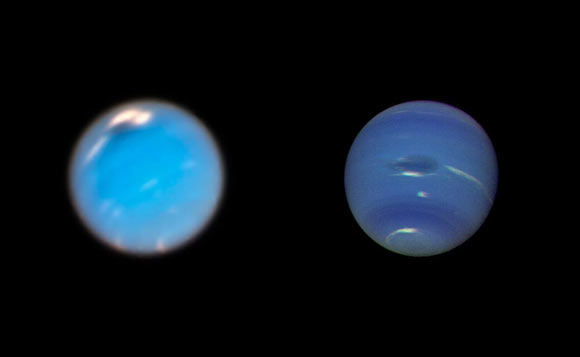A series of images taken by the NASA/ESA Hubble Space Telescope documents the formation of a Great Dark Spot on Neptune for the first time.

This is a composite picture showing images of storms on Neptune from Hubble (left) and Voyager 2 (right). The Hubble image shows a new dark storm (top center). In the Voyager image, a storm known as the Great Dark Spot is seen at the center. It is about 8,000 miles by 4,100 miles (13,000 km by 6,600 km) in size — as large along its longer dimension as the Earth. The white clouds seen hovering in the vicinity of the storms are higher in altitude than the dark material. Image credit: NASA / ESA / Hubble / GSFC / JPL.
In 1989, NASA’s Voyager 2 spacecraft zipped past Neptune — its final planetary target before speeding to the outer limits of the Solar System. As the craft zoomed by, it snapped pictures of two giant storms — the Great Dark Spot and the Dark Spot 2 — brewing in Neptune’s southern hemisphere.
Just five years later, Hubble took sharp images of Neptune from Earth’s distance of 2.7 billion miles (4.3 billion km).
Planetary scientists were eager to get another look at the storms. Instead, Hubble’s photos revealed that both storms had vanished. They immediately began constructing computer simulations in order to understand the mysterious disappearance of the storms.
Now part of the Outer Planet Atmospheres Legacy (OPAL) project, Dr. Amy Simon of NASA’s Goddard Space Flight Center and colleagues are beginning to answer these questions.
In 2015, the OPAL team began a yearly mission to analyze images of Neptune captured by Hubble and detected a small dark spot in the southern hemisphere.
Each year since, the researchers have viewed the giant planet and monitored the storm as it dissipated. In 2018, a new dark spot emerged, hovering at 23 degrees north latitude.
“We were so busy tracking this smaller storm from 2015, that we weren’t necessarily expecting to see another big one so soon. That was a pleasant surprise. Every time we get new images from Hubble, something is different than what we expected,” said Dr. Simon, first author of a paper published in the journal Geophysical Research Letters.
What’s more, the storm’s birth was caught on camera. While analyzing Hubble images of Neptune taken from 2015 to 2017, the team discovered that several small, white clouds formed in the region where the most recent dark spot would later appear.
The high-altitude clouds are made up of methane ice crystals, which give them their characteristic bright, white appearance. These companion clouds are thought to hover above the storms, similar to the way that lenticular clouds cap tall mountains on Earth.
Their presence several years before a new storm was spotted suggests that dark spots may originate much deeper in the atmosphere than previously thought.
“In the same way a terrestrial Earth satellite would watch Earth’s weather, we observe the weather on Neptune,” said Dr. Glenn Orton, a planetary scientist at NASA’s Jet Propulsion Laboratory.
Dr. Simon and co-authors also used images from Hubble and Voyager 2 to pinpoint how long Neptunian storms last and how frequently they occur.
They report in a second study published today in the Astronomical Journal that they suspect new storms crop up on Neptune every four to six years.
Each storm may last up to six years, though two-year lifespans are more likely.
“These discoveries on Neptune will have implications for those studying exoplanets in our Galaxy that are similar in size to the ice giants,” Dr. Simon said.
“If you study the exoplanets and you want to understand how they work, you really need to understand our planets first. We have so little information on Uranus and Neptune.”
_____
A.A. Simon et al. Formation of a New Great Dark Spot on Neptune in 2018. Geophysical Research Letters, published online March 25, 2019; doi: 10.1029/2019GL081961
Andrew I. Hsu et al. Lifetimes and Occurrence Rates of Dark Vortices on Neptune from 25 Years of Hubble Space Telescope Images. AJ 157, 152; doi: 10.3847/1538-3881/ab0747







